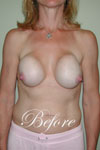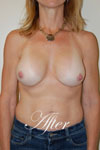Revisionary Breast Surgery in San Diego
Jump To
View Revisionary Breast Gallery
As the desire for Breast Enhancements increase so does the need for Revisionary Breast Surgeries. In 2007, plastic surgeons performed a total of 347,524 breast augmentation surgeries, up from just 212,500 in 2000, making breast augmentations the most widely performed cosmetic surgery procedure in 2007. This statistic represents a 64 percent increase over the number of procedures performed in the year 2000. Not every breast procedure performed is going to have 100 percent satisfaction result. Dr. Mofid understands this and feels prospective patients should have the option to obtain outstanding results. A revision surgery is more complex than the original breast surgery that was performed and requires an experienced surgeon to pay attention to detail and give the patient exactly what they yearn for.
Patients that are dissatisfied with the size or shape of their breasts or nipple position may opt to have additional surgery to increase or decrease the size of their breasts or to change the appearance of their nipple-areola complex. If shape is the major concern, a mastopexy (breast lift) can be performed to give the breast a more youthful appearance. Capsulated breast (hardening of implants), and ruptured or deflated breast implants require ex-plantation and re-augmentation of the implants. If the original augmentation has caused a deformity or if the implant pocket is too large or too small or in the wrong plane, additional surgery may be necessary. If you are experiencing any of these issues, you are invited to meet with Dr. Mofid to discuss your options and concerns.
Dr. Mofid has pioneered a new surgical technique for the replacement of implants placed on top of the muscle to the plane under the muscle using Alloderm®. He has taught this technique to other plastic surgeons at regional and national conferences and the article is in press within The Aesthetic Surgery Journal and set for publication in early 2009.
Patients interested in cosmetic face, body, or breast surgery may also visit his La Jolla office for more information on financing or to learn more about the cost of his procedures. Please apply for CareCredit® online to receive instant approval.
More Information about Revisionary Breast Surgery – By Dr. Mofid
Revisionary breast surgery is performed typically for the revision of breast implants that are malpositioned, have developed capsular contracture, excessive rippling or wrinkling, fold asymmetry or other implant-related complications.
There are a variety of reasons that breast augmentation surgery may result in dissatisfaction. Fortunately, most implant-related complications can be treated using a variety of techniques often times in association with the use of biologic grafts such as acellular dermal matrix or other graft materials. Depending upon the original cause for the need for breast revision surgery, different techniques may be utilized for the treatment of unique problems. For example, in the event that a patient develops excessive rippling or wrinkling of breast implants or severe capsular contracture when the implant is placed in the subglandular plane, implants may be moved into the subpectoral plane using a biologic graft material such as acellular dermal matrix products or other biologic grafts. In the event of a symmastia, implants can be moved into a different surgical plane to relieve or treat this problem. There are times when implant malposition can occur in association with fold asymmetry, and these problems may be treated with capsular work and internal suturing.
Despite the fact that revisionary rates for patients experiencing implant-related complications are higher than patients that have undergone primary breast augmentation without complications, many patients are satisfied and do experience significant improvement from their original problems.
These surgical procedures can take anywhere from 1 to 4 hours depending upon the procedure being performed and recovery is typically 2 weeks before returning to moderate exercise and 4 weeks before returning to most unrestricted activities.
Again, there are many reasons that patients do choose to have revisionary breast surgery, and depending upon the problem being treated, many different surgical tools can be utilized to improve patient outcomes.
Article on CosmeticTown.com
Seri Surgical Scaffold™ for Periareolar Mastopexy
September 2014
Traditional sutures
Recurrence of areolar dilatation following circumareolar mastopexy is among the most vexing problems in revisionary breast surgery. Historically, the gold standard for performing these procedures involves the use of non-absorbable monofilament sutures like a cercalage suture, which is akin to the cinch on a trash bag. Unfortunately, recurrent areolar dilatation over time using this technique is the norm rather than the exception. It is conceptually improbable to expect that the skin will not relax around permanent sutures over time.
Seri Surgical Scaffold Introduction
With the introduction of Allergan’s SERI Surigical Scaffold™, 510(k) cleared by the FDA, earlier this year, a novel use for this technologically advanced product designed for soft tissue support has been identified for periareolar mastopexy surgery. SERI Surgical Scaffold™ is made from a purified silk-derived bioprotein and woven into a porous design. It is free of human or animal tissues and has excellent biocompatibility and bioresorption properties. The Scaffold allows ingrowth of connective tissue leaving behind tissue that has 2-3 times the strength of fascia. By raising surrounding mastopexy skin flaps and incorporating a donut of SERI around the areola, the tension is evenly taken off of the surrounding skin flaps and the resultant matrix provides excellent support to prevent recurrent areolar dilatation.
Allergan
Support from Allergan has been provided to study SERI Surgical Scaffold™ in Institutional Review Board approved clinical trials for bottoming out and stretch deformities of the breast including implant malposition. A recent and ongoing clinical trial has been initiated to study the effect of SERI Surgical Scaffold™ for support in prevention of areolar dilatation in periareolar mastopexy.
Clinical Trials
Individuals interested in participating in the clinical trial investigating the use of SERI Surgical Scaffold™ are encouraged to contact our office. Ideal subjects for this study include those patients that have undergone previous periareolar mastopexy with resulting areolar dilatation as well as those patients interested in primary augmentation mastopexy using the circumareolar technique. SERI Surgical Scaffold™ will be provided free of charge and anesthesia and facility costs are subsidized. Participants will receive a stipend for each follow up visit.










